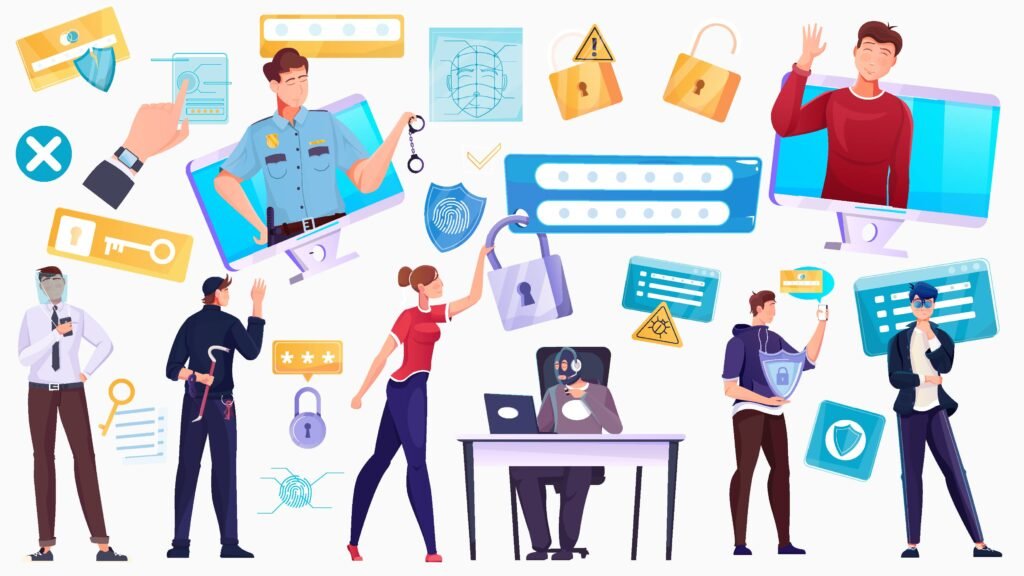Why Is Cyber Threat Intelligence Important?
In the fast-changing world of computers and the internet, knowing about online dangers ahead of time is super important for you. It’s like a lighthouse that helps ships to avoid hidden dangers in the sea. Cyber threat intelligence is just like that lighthouse but for the internet. It helps people and companies see and get ready for online attacks before they happen.
This kind of intelligence is all about being one step ahead. It’s not just about making your online defenses stronger; it’s about understanding what the attackers might do next. It turns simple information into something you can use to protect yourself. By being prepared, everyone from big companies to everyday folks can keep their online information secure. With online dangers always around the corner, having cyber threat intelligence is like having a secret weapon to protect yourself.
What is Threat Intelligence in Cyber Security?
At its core, learning about the threats in cyber security means figuring out, studying, and using information about possible dangers to defend yourself before anything bad happens. It’s like spying on a chess rival, guessing their next moves, and planning your game. This intelligence isn’t just random facts; it’s a mix of details that, when looked at closely, show what threats want to do, what they can do, and how bad they can be.
Gathering cyber threat intelligence means picking up bits of info from all over, like past online attacks, what’s currently happening in cyber threats, and what dangers might come up later. This info is then carefully sorted, studied, and changed into useful insights. What does this give you? A clear view of the dangers that might come after a company’s online space. By smartly using this knowledge, companies can make their online security stronger, not just by building higher barriers but by having smart plans in place for dangers that haven’t even shown up yet.
Defining each stage of the threat intelligence lifecycle
Going further into the world of understanding online dangers, it’s really important to know about the main process behind it, called the threat intelligence lifecycle. Think of it like a smooth-running machine that turns a bunch of raw information into helpful tips you can use. This process has a few steps, and each one is super important for you to make sense of all the confusion.
- Planning and Direction: It all starts with knowing what you need to watch out for. Companies decide which information they need to stay secure. They ask important questions and figure out what to keep an eye on.
- Collection: Now, it’s time to collect information from all over from technology sources, people, and public data. This step is about grabbing as much useful information as possible from everywhere.
- Processing: The collected data is usually a big, messy pile. Now, it needs to be cleaned up and organized so it makes sense. This is when raw data starts to look like something you can understand.
- Analysis: This is the core of the whole thing. Experts dig into the organized data with their tools and brains to spot patterns, trends, and odd stuff. They’re looking to find out meaningful things about possible dangers.
- Dissemination: Knowing stuff is great, but you’ve got to tell the right people about it in the way they get it. This step is about getting those important insights out to the folks who need them.
- Feedback: The process doesn’t just go in a straight line; it goes around and around. Getting thoughts and opinions back from the people who got the information is key to making the whole process better and keeping the insights useful and up-to-date.
By carefully going through each of these steps, companies can create a flexible and alert system for spotting online threats. This system gets better over time, changes as new dangers pop up, and keeps making their online security stronger.
What are the different types of threat intelligence?

Digging into cyber threat intelligence shows us a big mix of different kinds of information, each with its job in keeping our digital world secure. It’s like knowing when to use a small, precise tool like a scalpel or a big one like a sword each one is meant for a certain job.
- Strategic Threat Intelligence: This gives you a wide view of online dangers, focusing on big trends and why cyber-attacks happen. It’s more about seeing the overall effect on businesses and whole industries rather than the tiny details. Imagine it as looking at a huge map of an area you’ve never seen before.
- Tactical Threat Intelligence: This zooms in on the specific methods and tricks that hackers use. It’s like knowing the special moves your opponent might try in a game, giving you a heads-up on how they might attack. This information is very helpful for the people directly fighting these threats, as it helps them spot and stop attacks more effectively.
- Operational Threat Intelligence: This type gets into the nitty-gritty of individual cyber attacks or campaigns. It’s all about gathering detailed information on a particular threat figuring out who’s behind it, what they’re after when it happened, and how they did it. This detailed look is key to understanding an attack fully and responding in the best way.
- Technical Threat Intelligence: This is the most detailed level, focusing on the technical clues left behind by cyber attacks, like specific types of malware, harmful IP addresses, and dangerous web links. Think of it as collecting the fingerprints and other clues at a crime scene, which are essential for spotting and stopping continuous threats.
Each kind of intelligence is very important for a full-on defense plan, giving us different layers to understand and fight against online dangers. By using a mix of these intelligence types, companies can get a well-rounded picture of the threats out there, making their defenses stronger and tougher.
Implementation Challenges and Solutions
The idea of using cyber threat intelligence to protect against online dangers is a smart move, but it’s not always easy to do. To tackle these problems, you need a mix of good planning, the right tech, and sharp thinking from people.
- Data Overload: Imagine that you trying to drink water straight from a fire hose – that’s how it feels with the massive amount of data out there. It’s tough to spot the really important stuff in such a huge flood of information. What to Do Now: Using smart technology and learning machines can help us sort through all that noise. It’s like finding the important needles in a giant haystack and focusing on what counts.
- Integrating Intelligence into Security Operations: Having all this smart information is great, but it’s useless if you don’t know how to apply it. It’s like having a fancy sports car but not knowing how to drive it. What to Do Now: Teams that handle intelligence and those who manage security need to work together like best friends. They should use the insights to come up with smart security moves. Practicing together through training and mock drills can make this teamwork even better.
- Evolving Threats: Cyber threats are like sneaky chameleons, always changing their colors to sneak past our guards. Trying to keep up with them is like playing tag with your eyes closed. What to Do Now: We need to stay on our toes and be ready to change our game plan at any moment. Learning all the time, sharing tips with others in the security world, and tweaking our strategies on the fly can help us stay one step ahead.
- Skill Gaps: Understanding all the ins and outs of cyber threats needs some serious know-how. Right now, finding experts in this field is as hard as finding a top-notch piano player when most folks can barely tinkle “Twinkle Twinkle Little Star.” What to Do Now: Teaching and growing our skills is very important for you. We can also team up with other groups and share our smarts to make up for any missing pieces, tapping into the wider world of cyber-savvy folks.
By tackling these problems with smart solutions, companies can make the most of cyber threat intelligence. This means turning weak spots into strong shields. It’s all about changing problems into chances to make our online world tougher and safer.
The Final Word on the Importance of Cyber Threat Intelligence
In the big picture of cybersecurity, cyber threat intelligence plays a crucial and central role. Think of it as a compass that helps us steer through the choppy waters of online dangers, shining a light on the way to security. In a world where digital threats are as common as the sunrise, we really can’t downplay how important this intelligence is.
But cyber threat intelligence isn’t just about guarding against attacks; it’s about giving organizations the power to act. It arms them with the knowledge they need to make smart choices, turning their usual defensive stance into a forward-thinking plan. This way, their defenses aren’t just walls waiting to be knocked down but are more like smart shields that change and get better with every new challenge.
Furthermore, the benefits of this intelligence go beyond just one company; it helps you to make the whole online community stronger. When we share what we know and learn from each other, not only do we make our defenses stronger, but we also help make the online world safer for everyone.
To wrap it up, cyber threat intelligence is a key piece of the puzzle in today’s online security plans. It’s like having a keen eye that can spot trouble lurking in the shadows, always staying one step ahead of potential threats. In the ongoing fight against online dangers, it’s more than just helpful; it’s essential. As we move forward, the importance of cyber threat intelligence is only going to increase, making it an invaluable partner in our journey toward a safer digital space.
In conclusion
In the complex world of online security, cyber threat intelligence is like the mastermind behind the scenes, making sure every move is smart and ahead of the game. This article has taken us through what cyber threat intelligence is all about, how it works, its different forms, the hurdles it faces, and just how crucial it is for strong cyber security. It’s obvious that with the constant change in online threats, having this intelligence is not just helpful; it’s necessary. When organizations bring cyber threat intelligence into their game plan, they can tackle the digital world’s challenges with more confidence and strength. As we keep moving towards a more digital age, the wisdom and forward-thinking that cyber threat intelligence provides will continue to be key in keeping our online spaces secure, making sure we’re always one step ahead in this ongoing battle against cyber troublemakers.
FAQs
1. What is cyber threat intelligence and why does it matter?
Cyber threat intelligence involves analyzing information about potential cyber threats to prevent attacks. It’s crucial for proactive defense and informed decision-making in cybersecurity strategies.
2. How does cyber threat intelligence benefit an organization?
It enables organizations to anticipate, identify, and mitigate potential cyber threats before they can cause harm, enhancing overall digital security and resilience.
3. Can small businesses benefit from cyber threat intelligence?
Absolutely. Cyber threats do not discriminate by size; small businesses can significantly reduce their risk by understanding and preparing for potential cyber-attacks.
4. Is cyber threat intelligence only about technology?
While technology plays a key role, cyber threat intelligence also involves understanding the tactics, techniques, and procedures of cyber adversaries, requiring a blend of technical and analytical skills.
5. How often should an organization update its cyber threat intelligence?
Cyber threats are constantly evolving, so it’s essential for organizations to continuously update their threat intelligence to stay ahead of potential security breaches.







